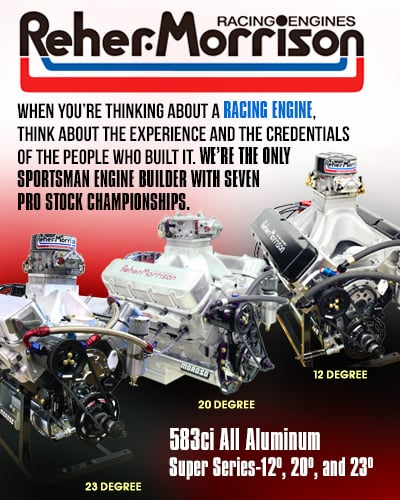McMILLEN ESTABLISHES HIMSELF AS OWNER WITH VISION, ACTION
National Hot Rod Association Top Fuel owner-driver Terry McMillen distinguished himself this year as a crossover from the IHRA Alcohol Funny Car ranks who  kept the track clean all season long, brought some enthusiasm, and barely missed the Countdown by a razor-thin margin at the final qualifying race.
kept the track clean all season long, brought some enthusiasm, and barely missed the Countdown by a razor-thin margin at the final qualifying race.
But even more refreshing is the Hoosier Thunder Motorsports owner's approach to having driving teammate Austin Lambright, who'll double as his car chief and engine builder. Naturally, he will welcome the extra data, but that isn't why he'll field a second car for five races in 2011. For McMillen, it's all about marketing, serving his economic partners, and helping the sport grow.
McMillen might project thunder with his lightning-quick, 7,000-horsepower Amalie Oil Dragster and his storm of gusto. But his real contribution is a sunny outlook about the future of drag racing and a fresh-breeze effort to train young mechanics and drivers, attract non-traditional partners, and encourage the NHRA and his colleagues to work together to support each other in this tough economic climate.

National Hot Rod Association Top Fuel owner-driver Terry McMillen distinguished himself this year as a crossover from the IHRA Alcohol Funny Car ranks who  kept the track clean all season long, brought some enthusiasm, and barely missed the Countdown by a razor-thin margin at the final qualifying race.
kept the track clean all season long, brought some enthusiasm, and barely missed the Countdown by a razor-thin margin at the final qualifying race.
But even more refreshing is the Hoosier Thunder Motorsports owner's approach to having driving teammate Austin Lambright, who'll double as his car chief and engine builder. Naturally, he will welcome the extra data, but that isn't why he'll field a second car for five races in 2011. For McMillen, it's all about marketing, serving his economic partners, and helping the sport grow.
McMillen might project thunder with his lightning-quick, 7,000-horsepower Amalie Oil Dragster and his storm of gusto. But his real contribution is a sunny outlook about the future of drag racing and a fresh-breeze effort to train young mechanics and drivers, attract non-traditional partners, and encourage the NHRA and his colleagues to work together to support each other in this tough economic climate.
"There's very little youth coming up in our industry. And the ones who are coming up want to drive. Not everybody can be drivers. The problem is that it's a small circle today [from which] to pick crew chiefs," he said after announcing major associate sponsorship from the University of Northwestern Ohio (UNOH).
The school -- which has been involved with ARCA, NASCAR Sprint Cup, and the NASCAR Whelen Modified Tour and previously linked with Don Schumacher Racing -- joins McMillen's program for hospitality to recruit prospective students to learn at its Jeff Jarvis High Performance Motorsports Complex at the Lima, Ohio, campus. UNOH graduate Marla Weidenaar has joined McMillen's crew, and the owner-driver said, "is here to pull her own work and has been a great asset."
The persistent Weidenaar, who describes herself as a utility worker, said she "saw that Terry's team was growing and that it's a place I'd be able to learn quickly but learn right."
So with 23-year-old Lambright also in the same age group as UNOH students, McMillen is establishing himself as an owner-driver who understands the overall picture and is contributing more than just talk.
"Terry McMillen is not going to save this program himself," he said. "But what I'm hoping is that others start seeing the trend and start going that way. Young guys are pretty sharp. They have a different approach, and sometimes it works. So you've got to listen to them."
He knows that when a team supplements the fresh ideas with the experienced formulas, the operation has not just data but also wisdom.
"That's the whole power of being a team," McMillen said. "You have to believe in your people. I seldom do anything on my car anymore. I don't even pack my parachute, because of all the media and all the other obligations we have. But I know when I get in that car, I have the best, just as anybody else out there. My guys have done a great job preparing the car. Austin, or Richard [crew chief Hartman], is not going to let me in that car if there's something wrong."
Teaching young mechanics the nuts and bolts of drag racing is his mission. McMillen said, "It's only 3.8 seconds and a lot's going on. It's nitromethane. It's dying to be a bomb, and it can be that if you make mistakes." So his hand-on approach, with UNOH's assist, will provide practical experience for the next generation of technical leaders.
Lambright, a throwback in his desire to both drive and prep the car, will get his chance while preserving Hoosier Thunder Motorsports' NHRA presence.
"Putting Austin in the car is a back-up thing for my long-term program," McMillen said. "I know that I'm not going to drive forever, but I'm going to be a team owner. I am going to live and die drag racing till my days on Earth are gone. Why not take somebody who's young and mold them the way you've done things? For me it has worked.
"I'm not saying the way I do things is going to work for everybody else, and I'm not saying it can't be better. There's teams out there with a lot more money, but we've done it the only way I know how," he said, "and that's by working hard, knocking on doors, and making things happen.
"We may not be a top-10 [program] today, but we have a pretty good idea of marketing. If I could teach the young guys the marketing side of things and [how to] be a driver and know how to do everything on a car . . . I believe it's important to know how to work on everything on a car. That way when you go down the track, you can go back to the crew chief and say, 'The car did this. It did this . . . And he has a place to start.' And you can only improve by doing that," McMillen said. "If you're just a driver and you get in the car and you don't know the mechanics, you aren't going to give your crew chief any good information."
Besides, he said, the bottom line is that he's "all about knowing my long-term future's going to be in drag racing."
Should the NHRA move toward a driver-development program?
"I think NHRA is seeing that and talking about that," McMillen said, "because there is no other place to go and test these fuel cars. You can run a Pro Stock car anywhere. You can run most of these cars anywhere. But you can't just take Top Fuel [cars] and just dump them on some track and say, 'Here you go.' I think NHRA has recognized the problem.
"It also recognizes the fact that there's not a lot of youth coming up and it needs to take an active role in trying to put that together," he said. "Their approach with other universities, as far as technical schools, is one of the tools they [NHRA marketers, other officials] have tried to utilize."
Making the transition from learning to practical application is the key, and sometimes dollars are required to unlock that door.
"With our turndown in the economy, it's just so tough to get a nickel from anybody to do anything," McMillen said.
He said even the premier sanctioning bodies, such as IndyCar Series and NASCAR along with the NHRA, "are all struggling in their own ways, because all the dollars we're accustomed to have in sanctioning bodies aren't out there today. It's a trickle-down effect, and unfortunately it's going to take a little time to re-establish the economy. It's trickle-down. It's got to start at the top. But sanctioning bodies don't have the money they need to spend the money on development. It's never going to go anyplace. I believe there are some steps that could be taken in every sanctioning body to improve. And some of it doesn't cost money. Some of it's just common sense."
He said despite financial difficulties, all the participants should co-operate to solve problems.
"As a driver and owner, I sometimes see things one way and the sanctioning body sees it totally opposite. There needs to be better communication lines between everybody and not be driven off the dollars and who you are but more so that there are opportunities to change things that won't really cost us a lot of money to do it," McMillen said.
"Whether it's the oildowns in drag racing or the crashes in NASCAR, there's got to be ways of fixing some of this. But I think sometimes they have their tunnel vision and we have ours as owners and drivers, and sometimes it's tough to see the parity needed to fix those things," he said. "There's a lot that can be done in sanctioning bodies, but they're so short-handed right now, because everybody's cut corners and expenses. Everybody's job has probably grown tenfold in those organizations [to the point] where they can't target one thing. If the economy turns around and nothing changes, then that might be a problem."
He said his own program is fortunate, but that is because he designed it to reflect what he said he sees as the new paradigm of race-team funding.

 Terry McMillen knows where he stands on the issues, but he was a bit unsure about where he should stand Tuesday, Nov. 2 at The Strip at Las Vegas Motor Speedway.
Terry McMillen knows where he stands on the issues, but he was a bit unsure about where he should stand Tuesday, Nov. 2 at The Strip at Las Vegas Motor Speedway.The Hoosier Thunder Motorsports owner-driver never had needed to know before. He's usually in the cockpit, absorbing the moment of a Top Fuel staging and launch sitting just inches above the pavement, the crowd a colorful blur in his peripheral vision, the grey ribbons of racing surface stretched out straight in front of him, tempting him.
But 23-year-old Austin Lambright was bringing McMillen's Amalie Oil Dragster through the staging lanes, rolling it up to the starting line, eager to make his first pass in the nitro-burning beast after five years of building its engines, working on its superchargers, packing its parachutes, and sending McMillen on five-second thrill-rides.
Shop mate Tad Heflick was watching it all from the tow vehicle but couldn't avoid having to dodge the pacing McMillen, too.
READ THE FULL STORY
"We have a lot of people who believe in us and believe in our program and understand our vision," McMillen said. "I think the days of $3 million to one team from one company are gone. I don't even know that that's happening in NASCAR today. I could be wrong. But I believe today you need to have four or five sponsors so that if you lost one partner it's not as catastrophic as if you lost the only one you have."
Kenny Bernstein, for example, took a big hit financially (and, for what it's worth, in sentimental value) when Budweiser pulled its funding after three decades. However, through the years, he had accumulated a garage full of associate sponsors who reduced the need for him to seek, by traditional yardsticks, a blockbuster sponsor.
"Just being able to reach out and have new marketing partners is a huge thing. It's so non-existent today," McMillen said.
Lambright's situation serves as a perfect example.
"It certainly helps you to have data," he said but clarified, "My goal next year is to drive in all 22 races and over-deliver for my marketing partners by putting Austin in a second car, not to show we got a ton of money or not to brag about anything but to help all my marketing partners. It's certainly going to be noticed and draw more attention to my marketing partners."
What might help McMillen is his emerging similarity to popular and business-savvy John Force. McMillen has earned scores of NHRA fans with his zealous post-run interview and his media-navigation skills.
"I've always been that way in IHRA," he said of his exuberance. "Coming to my first year in NHRA, winning a round was like winning a championship for me. Then it seems like we couldn't buy a round, and the whole monkey routine came out. It was good press. But more importantly, it was a sigh of relief when we were able to get that monkey off our back. So I have a lot of emotion, because I know the hard work you put in to make this happen. That emotion just stays built up, and all of a sudden you get that opportunity."
Jim Oberhofer, Team Kalitta manager, told McMillen that he hopes someday to put his own driver, Doug Kalitta, in the final against the "thunder" of Hoosier Thunder Motorsports.
"If you win," "Jim O" said, "I've never been down to the to end for an interview, but I'm going to go down there for yours."
"I have nothing to lose or gain" by being animated, McMillen said. "John Force is an icon of the sport. On one hand, it's a compliment to be compared to him, but on the other side, I'm just my own person. Maybe that's the age group; maybe that's the way we were designed at the time.
NHRA Top Fuel legend Shirley Muldowney said she doesn't buy into the saccharine scenario of flattering opponents after a round defeat. She said she sees no value in being chummy with the driver who just took money out of her pocket. McMillen said he understood that.
"If you look at the rivalry of Shirley and Don, it's still talked about today, 30 years later. There's something to be said for that."
The colorful NHRA personalities are no act, he said. "It's so natural for everybody. Everybody has their uniqueness, but everybody has the same emotion. There's excitement, there's joy. Look at Antron Brown," he said. "He comes out the car with energy. He's excited. He's pumped up. People want to see that -- it’s truly real."
Some drivers, the ones who nonchalantly chat about a round-win, "are like watching paint dry," McMillen said. "The people sitting in that armchair want to feel like you moved 'em out of that chair, that they're right there, listening to this thing live. You want to come across with energy so they feel the energy, And before you know it, they're your best fans."
He wants to survive. He has taken charge of his own mobility, barging ahead -- literally and figuratively -- just two weeks following replacement surgery for both knees right after the NHRA Finals in mid-November. He said his legs hurt but is determined to be healed completely for preseason testing next month at West Palm Beach, Fla.
McMillen also wants to survive the economic turmoil, the politics of drag racing, and the quest for original, young talent.
"You look at the dollar investment that's being poured out in the NHRA. There's only a handful of us who own and operate our own team anymore. Those days are gone, too. They seem to be dying," he said.
Ever optimistic, though, he said, "That's the great thing about drag racing. You can go out there on Sunday with your mom's minivan and race it. You're not going to go out to a NASCAR track and run around and know you didn't hurt anything and hit the wall."
Still, he said drag racing needs to project its modern image rather than allowing the pioneering says to define it.
"I think the persona of drag racing still to his day is the old '50s days, when you rolled up a pack of cigarettes in your T-shirt and it was just a drinking beerfest and oh, by the way, we're going to race a few cars here. Today it's such an organized business," he said. "It's amazing to me that the folks that have had that persona and get up close are overwhelmed. They would just never, ever believe that it's that way.
"I think it’s our job as drivers and owners, as well as the sanctioning body's, to figure out how to get those people there," he said. "There's got to be a tool to get them there. I don't know the best scenario to do that, but once we get them there, they'll be there forever."
Terry McMillen is living proof.
{source}
<div style="float:left; padding:5px;"><script type="text/javascript">
google_ad_client = "pub-8044869477733334";
/* 300x250, created 4/3/09 */
google_ad_slot = "2028912167";
google_ad_width = 300;
google_ad_height = 250;
</script>
<script src="http://pagead2.googlesyndication.com/pagead/show_ads.js" type="text/javascript"></script>
</div><div style="padding:5px;">
<script type="text/javascript">
 sr_adspace_id = 2000000613807;
sr_adspace_id = 2000000613807; sr_adspace_width = 300;
sr_adspace_width = 300; sr_adspace_height = 250;
sr_adspace_height = 250; sr_ad_new_window = true;
sr_ad_new_window = true; sr_adspace_type = "graphic";
sr_adspace_type = "graphic";</script>
<script type="text/javascript" src="http://ad.afy11.net/srad.js?azId=2000000613807">
</script></div>
{/source}




































